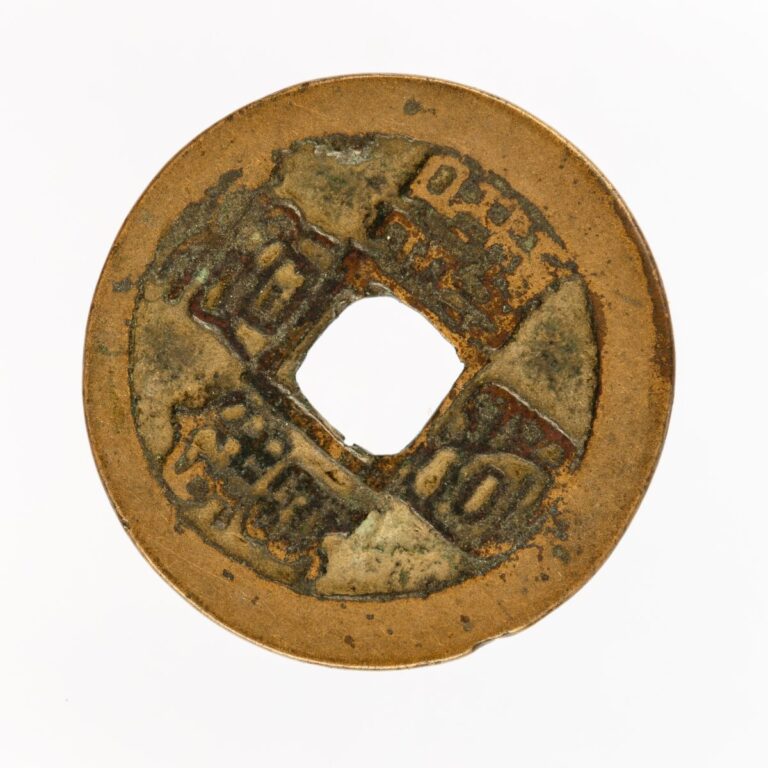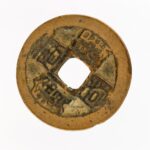Coin Tangguo tongbao
A round copper alloy coin with a square hole in the centre, called fangkong qian 方孔錢. These appeared in various denominations, mostly as tongbao 通寶 (“common currency”) coins, which were worth one monetary unit, yuanbao 元寶 (“original currency”) and zhongbao 重寶 (“heavy currency”) which had higher denominations. In many varieties and denominations, such coins had been in circulation as standard money since the time of Emperor Gaozu 高祖 (reigned 618–626), the first emperor of the Tang Dynasty (618–907) until the end of the Qing Dynasty (1644–1912). The inscription on the coin usually consists of two characters, reading from top to bottom, indicating the name of the reign or the period in which the coin was minted. The other two characters are to be read from right to left. On the left-hand side of the coin is usually the character bao 寶 (wealth, preciousness), which in combination ... more
A round copper alloy coin with a square hole in the centre, called fangkong qian 方孔錢. These appeared in various denominations, mostly as tongbao 通寶 (“common currency”) coins, which were worth one monetary unit, yuanbao 元寶 (“original currency”) and zhongbao 重寶 (“heavy currency”) which had higher denominations. In many varieties and denominations, such coins had been in circulation as standard money since the time of Emperor Gaozu 高祖 (reigned 618–626), the first emperor of the Tang Dynasty (618–907) until the end of the Qing Dynasty (1644–1912). The inscription on the coin usually consists of two characters, reading from top to bottom, indicating the name of the reign or the period in which the coin was minted. The other two characters are to be read from right to left. On the left-hand side of the coin is usually the character bao 寶 (wealth, preciousness), which in combination with the character on the right means “currency” or “money in circulation”. This is usually the character tong 通 (circulate, be uniform, general or universal), but often alsoyuan 元 (origin, basis) or zhong 重 (weight), which usually denote coins with a larger face value. Thus, the entire inscription literally means “money in circulation at the time of this or that emperor” or “in this or that period of a single emperor’s reign”.
The coin presented is the so-called Tangguo tongbao 唐國通寶 or “money of the Tang kingdom”, and the characters on its obverse are written in “official script” or lishu 隸書. It dates from the period of the so-called “Five Dynasties and Ten Empires” (Wudai shiguo 五代十國), i.e., the period of fragmentation that followed the fall of the Tang Dynasty in 907. Five officially recognised dynasties (wudai 五代) then lined up in northern China with their capitals at Kaifeng 開封 or Luoyang 洛陽, while at the same time ten kingdoms (shiguo 十國) existed for a short time in southern China. One of the most prosperous among them was the kingdom of South Tang or Nantang 南唐 (937–975), where this coin was also minted, under the rule of Yuanzong 元宗 (reigned 943–961), a descendant of the Tang dynasty emperors. (MG)





































Do you have a comment or additional information about the subject?